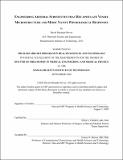| dc.contributor.author | Miranda-Nieves, David. | en_US |
| dc.contributor.other | Harvard--MIT Program in Health Sciences and Technology. | en_US |
| dc.date.accessioned | 2021-10-15T15:29:17Z | |
| dc.date.available | 2021-10-15T15:29:17Z | |
| dc.date.copyright | 2020 | en_US |
| dc.date.issued | 2020 | en_US |
| dc.identifier.uri | https://hdl.handle.net/1721.1/132985 | |
| dc.description | Thesis: Ph. D., Harvard-MIT Program in Health Sciences and Technology, September, 2020 | en_US |
| dc.description | Cataloged from the official PDF version of thesis. | en_US |
| dc.description | Includes bibliographical references (pages 107-118). | en_US |
| dc.description.abstract | Engineering small caliber (< 6mm) arterial grafts remains an unsolved problem. Current synthetic and autologous grafts suffer from short and long-term limitations including decreased patency rates, risk of bacterial infection, and compliance mismatching that results in neointimal hyperplasia. Tissue engineering is seen as a solution; however, a true arterial replacement remains elusive. Despite the numerous publications that have appeared over the last three decades, most reported strategies mimic functional and structural arterial properties to a limited extent. Furthermore, these strategies require long maturation times before implantation and carry the risk of failure in patients, who are often elderly with multiple comorbidities. Our central hypothesis was that living arterial substitutes that display normal physiological responses after in vivo implantation can be engineered through the controlled assembly of vascular cells and free-standing collagen sheets of controlled fibril orientation in a manner that recapitulates native vessel microstructure. We first present a scalable and continuous strategy for generating strong, free-standing, ultrathin, and centimeter-wide collagen sheets with controlled anisotropy using a flow-focusing approach. This strategy represents the first of its kind to generate anisotropic collagen sheets with control over nano- and macro-molecular properties. Next, controlled assembly of vascular cells and free-standing collagen sheets allowed us to design living blood vessels that recapitulated the arterial wall microstructure, and through structural, mechanical and biological characterization confirmed mimicry of native physiologic properties. We believe that the scalable fabrication schemes, and thorough characterization techniques, presented here will serve as a strong reference for future blood vessel tissue engineering efforts. | en_US |
| dc.description.statementofresponsibility | by David Miranda-Nieves. | en_US |
| dc.format.extent | 118 pages | en_US |
| dc.language.iso | eng | en_US |
| dc.publisher | Massachusetts Institute of Technology | en_US |
| dc.rights | MIT theses may be protected by copyright. Please reuse MIT thesis content according to the MIT Libraries Permissions Policy, which is available through the URL provided. | en_US |
| dc.rights.uri | http://dspace.mit.edu/handle/1721.1/7582 | en_US |
| dc.subject | Harvard--MIT Program in Health Sciences and Technology. | en_US |
| dc.title | Engineering arterial substitutes that recapitulate vessel microstructure and mimic native physiological responses | en_US |
| dc.type | Thesis | en_US |
| dc.description.degree | Ph. D. | en_US |
| dc.contributor.department | Harvard University--MIT Division of Health Sciences and Technology | en_US |
| dc.identifier.oclc | 1263358970 | en_US |
| dc.description.collection | Ph.D. Harvard-MIT Program in Health Sciences and Technology | en_US |
| dspace.imported | 2021-10-15T15:29:17Z | en_US |
| mit.thesis.degree | Doctoral | en_US |
| mit.thesis.department | HST | en_US |
